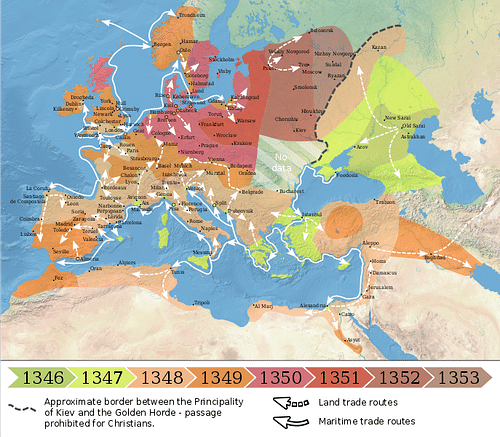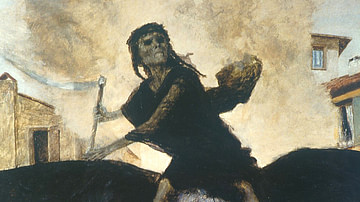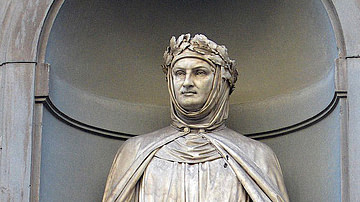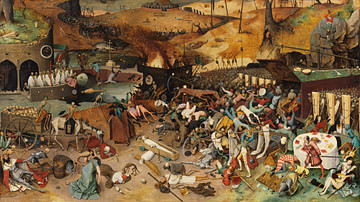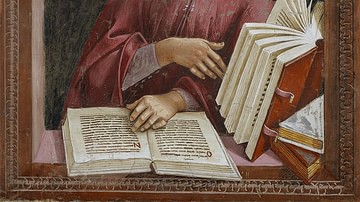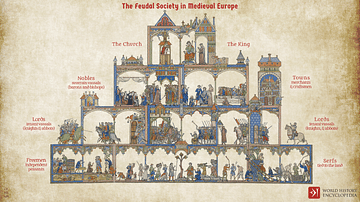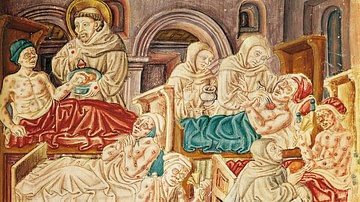The Black Death is the name given to the plague outbreak in Europe between 1347-1352 CE. The term was only coined after 1800 CE in reference to the black buboes (growths) which erupted in the groin, armpit, and around the ears of those infected as the plague struck the lymph nodes; people of the time referred to it as “the pestilence” among other terms. It came from the East where it raged between 1346-1360 CE and was a combination of bubonic, septicemic, and pneumonic plague.
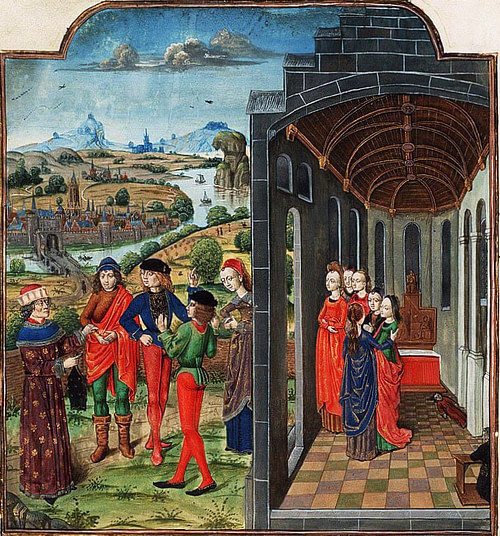
One of the primary sources on the outbreak was the Italian writer and poet Giovanni Boccaccio (l. 1313-1375 CE), best known for his work The Decameron (written 1349-1353 CE), which tells the story of ten people who entertain themselves with stories while in isolation from the plague. In the first chapter, before introducing the characters, he describes how the plague struck the city of Florence in 1348 CE, how people reacted, and the staggering death toll which would finally amount to between 30-50 million before it wore itself out. The outbreak would completely alter the European social structure as well as the belief systems of many of those who survived it.
Background to the Plague
The plague was caused by the bacterium Yersinia pestis which was carried by the fleas of rodents, primarily rats, who were transported between regions through trade or by troops returning from or heading toward deployment. This bacterium was not isolated and identified, however, until 1894 CE and so the people of the 14th century CE had no idea as to the cause of the plague or how to fight against it. The disease was therefore attributed to God's wrath, primarily, although marginal communities – such as the Jews – were also singled out as the cause and persecuted accordingly. Most responses, however, were aimed at appeasing the anger of God and there were few practical efforts – at least at first – towards controlling the spread of the disease.
The plague entered Europe from the East via Genoese trading ships but is also thought to have possibly been spread along the Silk Road trade routes. The disease had been taking a significant toll in the East since at least 562 CE – thought to be a continuation of the Plague of Justinian (541-542 CE and afterwards) – quieted down in 749 CE, and flared up again in 1218 CE. Afterwards, it died down again until 1332 CE and broke out fully in 1346 CE before traveling to Europe.
The point-of-origin most scholars agree on are the Genoese ships from the port city of Caffa (also given as Kaffa) on the Black Sea (modern-day Feodosia in Crimea). The city had been under siege by the Mongol Golden Horde under the command of Khan Djanibek (r. 1342-1357 CE) whose troops were infected by the Plague of the Near East. When soldiers died, Djanibek ordered their corpses catapulted over the walls of Caffa, and this is thought to have infected the city's population. Merchant ships fleeing the city went first to Sicily, then Marseilles and Valencia, infecting them, and the plague then spread across Europe.
Boccaccio's Narrative
In 1348 CE, it struck Florence, Italy, Boccaccio's native city, killing his stepmother (his mother had died earlier, possibly of plague). His father worked in finance and trade and held the government position of Minister of Supply before dying, probably of plague, in 1349 CE, the same year Boccaccio would begin writing The Decameron. This work features ten young people – seven women and three men – who have fled Florence during the plague and taken shelter in a villa in the countryside. To entertain themselves, they tell the stories which make up the bulk of the book.
The introduction to The Decameron, which details the outbreak in the city, is given by the narrator of the work as background before the appearance of the ten main characters, all of whom meet at an empty church in the city in the midst of the plague before deciding to leave for the country. It is unclear whether Boccaccio was actually present in Florence when the plague was raging there, as his father may have sent him to Naples on business in 1348 CE, but he certainly could have been and so would serve as an eyewitness to the devastation of the city. The introduction, though part of a fictional work, is still considered an accurate description of life in Florence during the plague as it matches with other accounts.
Although Boccaccio claims that the first symptom of the disease is the appearance of buboes, most records of the plague indicate that it began with fever, then body aches and fatigue, and then the buboes breaking out on the body. It is possible Boccaccio made use of poetic license and reversed the order of symptoms to give the worst up front for dramatic effect, but it also could simply be that this was his personal experience of the plague.
The Text
The following comes from The Decameron as translated by Mark Musa and Peter Bondanella, 1982 CE. The account has been edited for space with omissions indicated by ellipses.
Let me say, then, that thirteen hundred and forty-eight years had already passed after the fruitful Incarnation of the Son of God when into the distinguished city of Florence…there came a deadly pestilence. Either because of the influence of heavenly bodies or because of God's just wrath as a punishment to mortals for our wicked deeds, the pestilence, originating some years earlier in the East, killed an infinite number of people as it spread relentlessly from one place to another until finally it had stretched its miserable length all over the West. And against this pestilence no human wisdom or foresight was of any avail; quantities of filth were removed from the city by officials charged with the task; the entry of any sick person into the city was prohibited; and many directives were issued concerning the maintenance of good health. Nor were the humble supplications rendered not once, but many times, by the pious to God, through public processions or by other means, in any way efficacious.
Almost at the beginning of springtime of the year in question, the plague began to show its sorrowful effects in an extraordinary manner. It did not assume the form it had in the East, where bleeding from the nose was a manifest sign of inevitable death, but rather showed its first signs in men and women alike by means of swellings either in the groin or under the armpits, some of which grew to the size of an ordinary apple and others to the size of an egg (more or less), and the people called them gavoccioli (buboes). And from the two parts of the body already mentioned, in very little time, the said deadly gavoccioli began to spread indiscriminately over every part of the body; then, after this, the symptoms of the illness changed to black or livid spots appearing on the arms and thighs, and on every part of the body – sometimes there were large ones and other times a number of little ones scattered all around. And just as the gavoccioli were originally, and still are, a very definite indication of impending death, in like manner these spots came to mean the same thing for whoever contracted them. Neither a doctor's advice nor the strength of medicine could do anything to cure this illness; on the contrary, either the nature of the illness was such that it afforded no cure, or else the doctors were so ignorant that they did not recognize its cause and, as a result, could not prescribe the proper remedy (in fact, the number of doctors, other than the well-trained, was increased by a large number of men and women who had never had any medical training); at any rate, few of the sick were ever cured, and almost all died after the third day of the appearance of the previously described symptoms (some sooner, others later), and most of them died without fever or any other side effects.
This pestilence was so powerful that it was transmitted to the healthy by contact with the sick, the way a fire close to dry or oily things will set them aflame. And the evil of the plague went even further: not only did talking to or being around the sick bring infection and a common death, but also touching the clothes of the sick or anything touched or used by them seemed to communicate this very disease to the person involved…
There were some people who thought that living moderately and avoiding any excess might help a great deal in resisting this disease, and so they gathered in small groups and lived entirely apart from everyone else. They shut themselves up in those houses where there were no sick people and where one could live well by eating the most delicate of foods an drinking the finest of wines (doing so always in moderation), allowing no one to speak about or listen to anything said about the sick and dead outside; these people lived, entertaining themselves with music and other pleasures that they could arrange. Others thought the opposite: they believed that drinking excessively, enjoying life, going about singing and celebrating, satisfying in every way the appetites as best one could, laughing, and making light of everything that happened was the best medicine for such a disease; so they practiced to the fullest what they believed by going from one tavern to another all day and night, drinking to excess; and they would often make merry in private homes, doing everything that pleased or amused them the most. This they were able to do easily, for everyone felt he was doomed to die and, as a result, abandoned his property, so that most of the houses had become common property, and any stranger who came upon them used them as if her were their rightful owner…
Many others adopted a middle course between the two attitudes just described: neither did they restrict their food or drink so much as the first group nor did they fall into such dissoluteness and drunkenness as the second; rather, they satisfied their appetites to a moderate degree. They did not shut themselves up, but went around carrying in their hands flowers, or sweet-smelling herbs, or various kinds of spices; and they would often put these things to their noses, believing that such smells were a wonderful means of purifying the brain, for all the air seemed infected with the stench of dead bodies, sickness, and medicines…
And not all those who adopted these diverse opinions died, nor did they all escape with their lives; on the contrary, many of those who thought this way were falling sick everywhere…brother abandoned brother, uncle abandoned nephew, sister left brother, and very often wife abandoned husband, and – even worse, almost unbelievable – fathers and mothers neglected to tend and care for their children as if they were not their own..
Many ended their lives in the public streets, during the day or at night, while many others who died in their homes were discovered dead by their neighbors only by the smell of their decomposing bodies. The city was full of corpses…Moreover, the dead were honored with no tears or candles or funeral mourners; in fact, things had reached such a point that the people who died were cared for as we care for goats today…So many corpses would arrive in front of a church every day and at every hour that the amount of holy ground for burials was certainly insufficient for the ancient custom of giving each body its individual place; when all the graves were full, huge trenches were dug in all of the cemeteries of the churches and into them the new arrivals were dumped by the hundreds; and they were packed in there with dirt, one on top of another, like a ship's cargo, until the trench was filled…
What more can one say except that so great was the cruelty of Heaven, and, perhaps, also that of man, that from March to July of the same year, between the fury of the pestiferous sickness and the fact that many of the sick were badly treated or abandoned in need because of the fear that the healthy had, more than one hundred thousand human beings are believed to have lost their lives for certain inside the walls of the city of Florence – whereas before the deadly plague, one would not even have estimated there were actually that many people dwelling in the city.
Conclusion
Boccaccio's observation that religious supplications were of no use is reported by other sources on the plague which, like his, make clear that there was no other response which was any more useful. Various tracts were published offering advice but their suggestions were no more effective than prayer, fasting, and penitence had been. Scholar Don Nardo notes this in citing the medieval Italian writer Tommaso del Garbo who offered practical advice for people entering the homes of the infected:
Notaries, confessors, relations, and doctors who visit plague victims, on entering their houses, should open the windows so that the air is renewed and wash their hands with vinegar and rose water and also their faces, especially around their mouth and nostrils. It is also a good idea before entering the room to place in your mouth several cloves and eat two slices of bread soaked in the best wine and then drink the rest of the wine. Then, when leaving the room, you should douse yourself and your pulses with a sponge soaked in vinegar. Take care not to stay too close to the patient. (88)
None of the above, however, proved effective against the plague except the suggestion to keep one's distance from an infected person; known today as "social distancing". The port city of Ragusa (modern-day Dubrovnik, Croatia), which at that time was controlled by Venice, was the first to implement practical measures along these lines by isolating ships for thirty days under the policy of trentino (30 days) which was later extended to forty days under the law of quarantino (40 days) which gives English its word quarantine. Quarantine and social distance, therefore, were the only practical measures taken in stopping the spread of the disease and do seem to have been the only steps that had any effect.
Religious responses to the plague were numerous and included public processions of flagellants who would pass through cities, towns, villages, and fields whipping themselves while begging God for forgiveness of humanity's sins. These movements were finally condemned by the Pope as ineffectual but, to the people of the time, every other religious response was equally useless. The perceived failure of religion to stop, or at least alleviate, the suffering and death of the plague turned many away from the medieval Church to seek answers elsewhere; an impulse which would eventually give rise to the humanistic worldview of the Renaissance.
